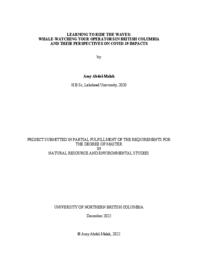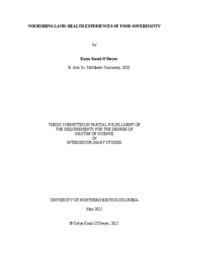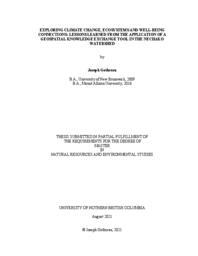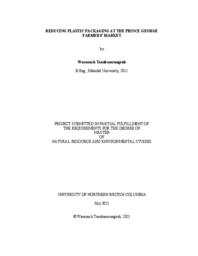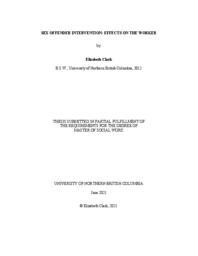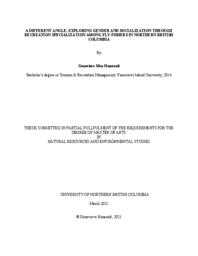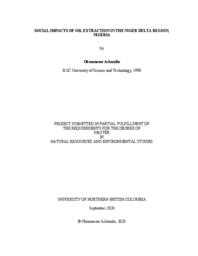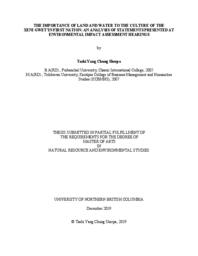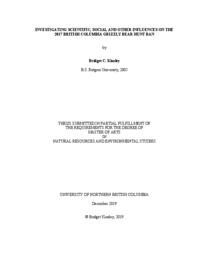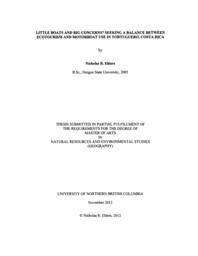Meletis, Zoë A.
Person Preferred Name
Zoë A. Meletis
Related Works
Content type
Digital Document
Description / Synopsis
Bear viewing poses significant risks for humans and wildlife, particularly in the form of "bear jams" - traffic congestion caused by people slowing down or stopping to view bears. This study addresses gaps in our understanding of the human dimensions of roadside bear viewing, focusing on the case study of Peter Lougheed Provincial Park (PLPP) in Alberta, Canada. A mixed-methods approach is employed in this study, comprising a survey (n=380) of visitors who have witnessed or engaged in roadside bear viewing and interviews with experts who have experience in bear-related fields (n=22). The main findings indicate that a balanced approach is needed to manage bears and humans. The study suggests human, bear, infrastructure, and habitat-related approaches, including implementing no-stopping zones, enforcing regulations, and improving education and outreach, are key to managing roadside bear viewing. The results of this study provide valuable insight for park managers and wildlife officials to develop effective management strategies that balance the needs of both humans and bears. The data collected in this study underscore the importance of a holistic and adaptive management approach to addressing roadside bear viewing. The findings apply to PLPP and parks facing similar challenges
Origin Information
Content type
Digital Document
Description / Synopsis
The COVID-19 era and related restrictions have impacted British Columbia (BC) whalewatching operators and their perspectives on whale-watching and tourism-government relations in BC. Despite the popularity and importance of whale-watching in BC, and its relative freedom from restrictions given its outdoor operations, tour operators had to negotiate dynamic constraints during the COVID-19 era. Federal and provincial government responses to the pandemic directly impacted whale-watching, for example, by changing the capacity or number of tourists allowed per vessel. Restrictions also impacted additional goods and services offered by some tour operators, such as refreshments. Adapting to such changes required a certain agility on the part of operators. Many operators also accessed key government supports such as loans and wage subsidies. This paper is based on a mixed methods research project centered on qualitative interview-based research and analysis. It was also informed by limited participant observation on whale-watching tours. Here, we present data gleaned from virtual interviews with 10 whale-watching tour operators. These operators represent approximately 1/4 of 39 active existing operators on and around Vancouver Island, British Columbia, Canada. We offer participant responses and greater response patterns with respect to: 1) how COVID-19 impacted whale-watching operations in BC, 2) what, if any, pivots or changes operators made in response, 3) which supports they accessed and their evaluations of them, and 4) their perspectives on the future of BC whalewatching. We begin with an introduction to: whale-watching in BC; COVID-19’s impacts on tourism as well as government responses to these; key concepts such as the Tourist Area Life Cycle, and ideas about how tourism weathers crises. We then present results highlighting key barriers, opportunities, and adaptations experienced by the tour operators, emphasizing their own words. We end by considering longer term implications for whale-watching in BC. This paper was written for both academic and applied audiences.
Origin Information
Content type
Digital Document
Description / Synopsis
Indigenous food sovereignty— a living reality prior to colonization, which violently disrupted Indigenous food systems—is characterized by Indigenous peoples’ self-determination in controlling their food systems and culturally informed foods practices. Directly related to ongoing coloniality, food insecurity is central to the disproportionately high burdens of poor health affecting Indigenous peoples. By exploring the health-related experiences of food sovereignty and Indigenous food sovereignty leaders living in northern BC, this project asks both: How does engaging in food sovereign practices affect peoples’ health? What are the factors that foster (or limit) food sovereignty practices? Being sensitive to past and ongoing colonial and paternalistic research approaches, this research enacts a community-informed ethos, anchored in community-based participatory research (CBPR) processes, wherein research is conducted with and for those involved. This research draws on qualitative methods, including semi-structured (virtual) interviews with community members and knowledge holders, including diverse food sovereignty and Indigenous food sovereignty champions. Champions are involved in various capacities, including direction of research design, engaging in interviews, and informing research outputs. Addressing gaps in the literature, this research documents holistic health experiences of food sovereignty and Indigenous food sovereignty leaders in northern BC. By highlighting experiences faced by those enacting food sovereignty practices, this research offers a counterview to existing bodies of food and health-related research and literature that rely predominantly on quantitative food security metrics. This project’s findings contribute to a growing body of scholarship documenting food sovereignty praxis: the work thus has the potential to inform policy that helps to support the resilience and self-determination of those doing food sovereignty and Indigenous food sovereignty.
Origin Information
Content type
Digital Document
Description / Synopsis
In response to the exclusion of Indigenous people from natural resources management, the Canadian federal government announced that they would provide $25 million over four years to support the development of Indigenous Guardians programs across Canada. The program was promised to “provide Indigenous Peoples with greater opportunity to exercise responsibility in stewardship of their traditional lands, waters and ice” (Government of Canada 2020). I used a case study approach to explore the role of this funding to support Indigenous communities in their Guardians initiatives. I facilitated semi-structured interviews with staff from five Indigenous Guardians programs from BC and Manitoba, Canada. Participants suggested that the federal pilot program was a step in the right direction to support environmental stewardship initiatives led by Indigenous governments or communities. In particular, this program was successful in increasing monitoring of the land, collaboration with like-minded groups, and facilitating the education of youth by community Elders.
Origin Information
Content type
Digital Document
Description / Synopsis
The Nechako Watershed is a large system in northern BC that exemplifies the challenge of integrating information across climate, environment and well-being. This research responded to this need with the goal of enhancing how information about the Nechako Watershed is communicated and shared. Informed by the development of a geospatial ‘portal’ tool in northern BC, this research sought to establish the Integrated Watershed Research Group (IWRG) Portal, gain insight on establishing accessible knowledge exchange strategies, and identify its perceived benefits and limitations. The research had two phases. Phase I involved working with a development team to understand this tool, testing, establishing the IWRG Portal, finding and formatting content. Phase II brought members of the Portal User Research Group together to further refine the IWRG Portal and content through scoping discussions, workshops, and a focus group. Thematic analysis was used to code and analyze the transcribed focus group. The research identified benefits of the portal with how it dealt with complexity and its integrative features. Limitations were also found, including the need for intentional framing of data, a steep learning curve, and the need for an internet connection. Analysis also identified the need to tailor content for specific audiences. The research has shown that tools such as the IWRG Portal can create new pathways to understanding and finding information. The research has also identified paths for further refinement and development of the portal tool by expanding the user base and continuing to evaluate the effectiveness of this tool in various contexts.
Origin Information
Content type
Digital Document
Description / Synopsis
Plastic pollution, a global problem, contributes to detrimental impacts on the environment. To mitigate plastic pollution locally,farmers’ market scan play a role in reducing plastic consumption. Many studies have suggested that customers and vendors are aware of environmental problems. Yet vendor environmental awareness does not always result in appropriate actions, as many vendors still rely on plastic packaging. To investigate the reasons for such reliance, I conducted vendor interviews and a customer survey at the Prince George (B.C.) Farmers’ Market. The results show that the barriers to reducing plastic include packaging availability, characteristics, functions, and price. Based on interview results, I developed a manual to support vendors interested in reducing plastic packaging at their stalls. I also offer recommendations as to how policy makers can motivate vendors and customers to reduce plastic consumption, such as offering customers reusable bags and organizing plastic-free events.
Origin Information
Content type
Digital Document
Description / Synopsis
This thesis argues that the witch trial of Zug, Switzerland, held between August of 1737 and January of 1738 provides a window into the world and spatial conceptualizations of lower status Catholic women living in eighteenth-century Switzerland. Through the examination of the accounts of the accused, the realities and fantasies held by these women are laid bare in the narratives of witchcraft they constructed, informing their interactions with the world around them. The marginal spaces of the Canton of Zug and the broader Swiss context were the backdrop to localized and broader diabolical concepts of witchcraft. Geographic information systems (GIS) databases and maps of the accused’s worlds as demonstrated through the trial record were created, allowing for the visualization of the records. These maps demonstrate that the boundaries of these women’s worlds were intrinsically tied to their regional Catholic identities, forming the basis of their interactions with the world around them.
Origin Information
Content type
Digital Document
Description / Synopsis
This paper describes a qualitative study involving six participants who work in the field of sex offender intervention. Participants’ struggles and professional rewards are examined. Recommendations on workplace policy and procedure adjustments are made based on the findings. Although participants identified rewards of their work, they described many physical, emotional, and mental health struggles they encountered, because of their employment. They also identified supports that promoted their wellbeing in the work.
Origin Information
Content type
Digital Document
Description / Synopsis
Studies of how gender is characterized, performed, and understood in outdoor activities in relation to skill development are limited, but growing. This research explored gender and social relationships across levels of recreation specialization in fly-fishing among anglers in Prince George, BC. Semi-structured interviews were conducted with 23 participants, 11 of whom then attended a level-specific fishing day during which participant observation was conducted. Interviews were transcribed and coded. Four main findings were derived. First, anglers’ social relationships shifted from dependence on others to intentional self-expression. Second, anglers learned to belong ecologically and socially through skill development and equipment use. Third, anglers’ relationships with fish moved from possession to communion. Fourth, anglers’ described escaping their daily routines to engage with rural places and fishing. The analysis and discussion show how masculinity was constructed and performed, and highlight the roles of socialization, behaviors, and equipment in shaping and gendering rural settings.
Origin Information
Content type
Digital Document
Description / Synopsis
The synergistic effects of anthropogenic disturbance, habitat fragmentation and climate change pose a significant threat to biodiversity that is challenging to predict. Anthropogenically driven climate change has already begun to impact critical climate regions and is now recognized to be one of the most serious threats to biodiversity and the conservation thereof. Despite this, few conservation planning initiatives have sought to sharpen the focus of the systematic conservation planning (SCP) framework to explicitly include climate change. To promote the evolution of the SCP framework into a climate change-conscious (CCC) approach to conservation planning, I developed and applied a methodology for incorporating climatechange resiliency into the SCP framework. This CCC-SCP methodology can be used to guide future conservation planning initiatives, helping conservation planners recognize and respond to opportunities for action, conserve our planet’s biodiversity and mitigate the effects of climate change.
Origin Information
Content type
Digital Document
Description / Synopsis
Understanding the mountain pine beetle detoxification systems is vital for predicting its continued spread into the novel jack pine host. Phylogenetic analyses were conducted for mountain pine beetle catalase, glutathione peroxidase, superoxide dismutase, and peroxiredoxin. These proteins were generally conserved, but there were differences in some key functional motifs. Specifically, a peroxiredoxin (DPPrx1) contained a unique combination of hyperoxidation motifs. DPPrx1 and a superoxide dismutase (DPSOD1) were selected for further functional analyses and demonstrated higher reactivity when compared to other SOD and Prx proteins. Also, DPPrx1 experiences hyperoxidation at a lower H2O2 concentration (~0.06 mM) than human peroxiredoxin (~0.12 mM). In other systems, hyperoxidized peroxiredoxin does act as a signal molecule for the expression of other oxidative stress proteins. Therefore, due to its relatively high reactivity and potential role as a cellular signal, DPPrx1 could serve as a future pest management target.
Origin Information
Content type
Digital Document
Description / Synopsis
Oil was discovered in Nigeria in1956 at Oloibiri in the Niger Delta Region after almost 50 years of exploration. Shell-BP at that time, was the sole concessionaire because non-British companies were not given exploration license to operate in Nigeria. After Nigerian Independence in 1960, exploration rights were extended to other multinational oil companies. More than 16 multinational oil companies were in operation with little or no supervision from the Nigerian Government, which created significant environmental, political,and social impact in the region. A critical discourse analysis of documents from Shell, Amnesty International, THISDAY Newspaper revealed that the Nigerian government has failed to safeguard the environment and the lives of the people. On the basis of evidence presented on this research, in addition to literature, it can be argued that oil has turned out to be a curse to the Niger Delta Region and Nigeria in general.
Origin Information
Content type
Digital Document
Description / Synopsis
An application for a new open-pit gold/copper mine in Tsilhqot’in territory raised concerns among the local Xeni Gwet’in people about potential impacts. This study examines statements about these concerns and potential impacts made by Xeni Gwet’in people during environmental assessment hearings. The research adopts a single case study approach, and the analysis uses a western social science method as well as a more holistic Indigenous approach to decolonizing research by placing Indigenous voices in the center of the research process. The results suggest that land and water are inseparable, as are their connections to the Xeni Gwet’in people, culture, and territory. Key findings include that land and water are central to Xeni Gwet’in identity and future, that they are used to demonstrate ‘control’ and ‘ownership’ of their traditional territory, and that they are crucial to Xeni Gwet’in intergenerational transfer of knowledge, culture, and sacred spiritual connections to their traditional territory.
Origin Information
Content type
Digital Document
Description / Synopsis
Ghana joined the league of oil and gas producing countries in 2007 when oil was discovered in the Gulf of Guinea. Through the years, however, concerns have emerged over the impacts of oil and gas activities on coastal livelihoods, especially since the benefits of extraction do not seem to trickle down to these communities. This thesis employs the Feminist Political Economy framework to examine the gendered disparities embedded in relations between offshore oil extraction and livelihoods of women in Ghana. Through an exploratory approach and a mixed methods design, I reveal how the intersection of culture, geography, politics, race and class foster the dispossession of coastal women. Among other findings, this thesis reveals that fishing is still the main source of livelihoods, and a culturally import source of food for the Western Region. It also shows that the advent of oil in the region has not improved but worsened women's livelihoods.
Origin Information
Content type
Digital Document
Description / Synopsis
British Columbia has the largest grizzly bear population in Canada. In 2017, B.C. banned the hunt of grizzly bears citing a lack of societal support, despite government-cited science that the hunt was sustainably managed. I explored the factors that influenced popular perceptions of grizzly bears, the hunt, how these factors may have influenced the province’s decision to implement the ban, and its reception by various actors. Methods included: examining key claims in government documents preceding the ban; surveying media coverage of the ban; and interviewing experts (n = 30) about their role in, and opinion of the ban. Results indicated that public perception of the hunt, and its framing as a trophy hunt outweighed scientific evidence of hunt sustainability. However, controversy over the representativeness of the “public opinion”, and comprehensiveness of government consultation processes remain. I suggest avenues for further research into roles of social values in natural resource policy.
Origin Information
Content type
Digital Document
Origin Information
Content type
Digital Document
Origin Information


